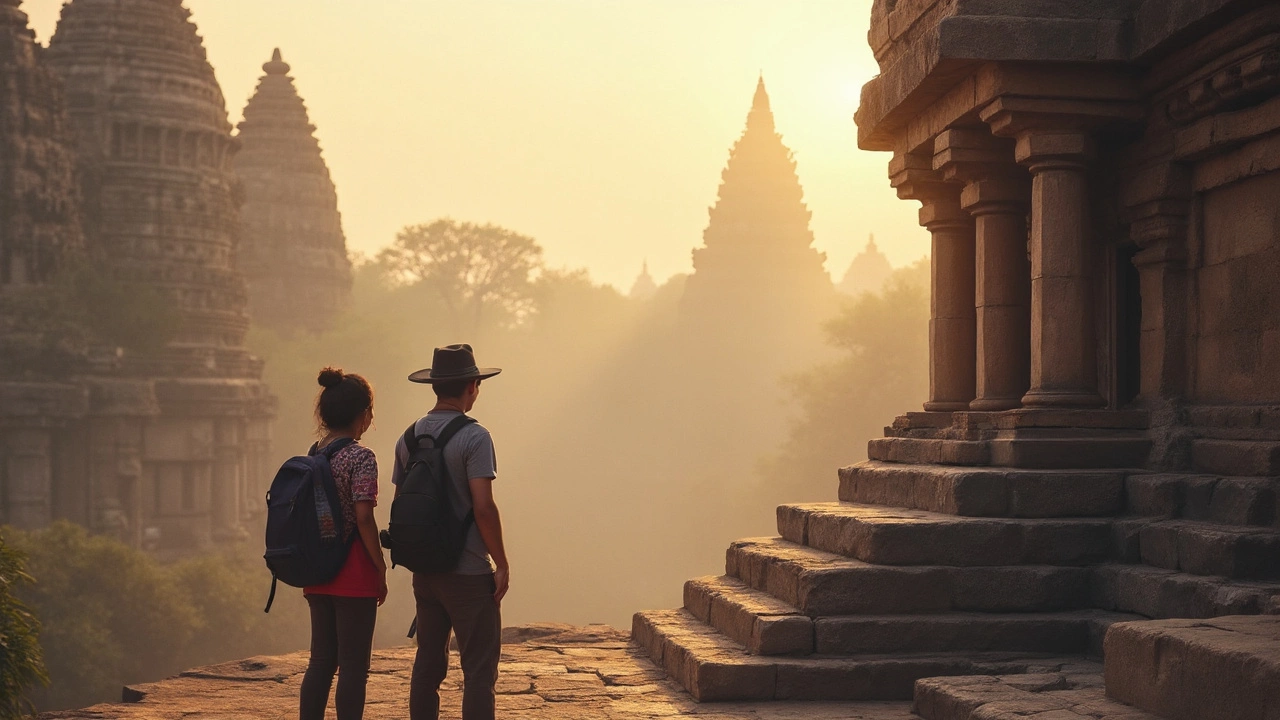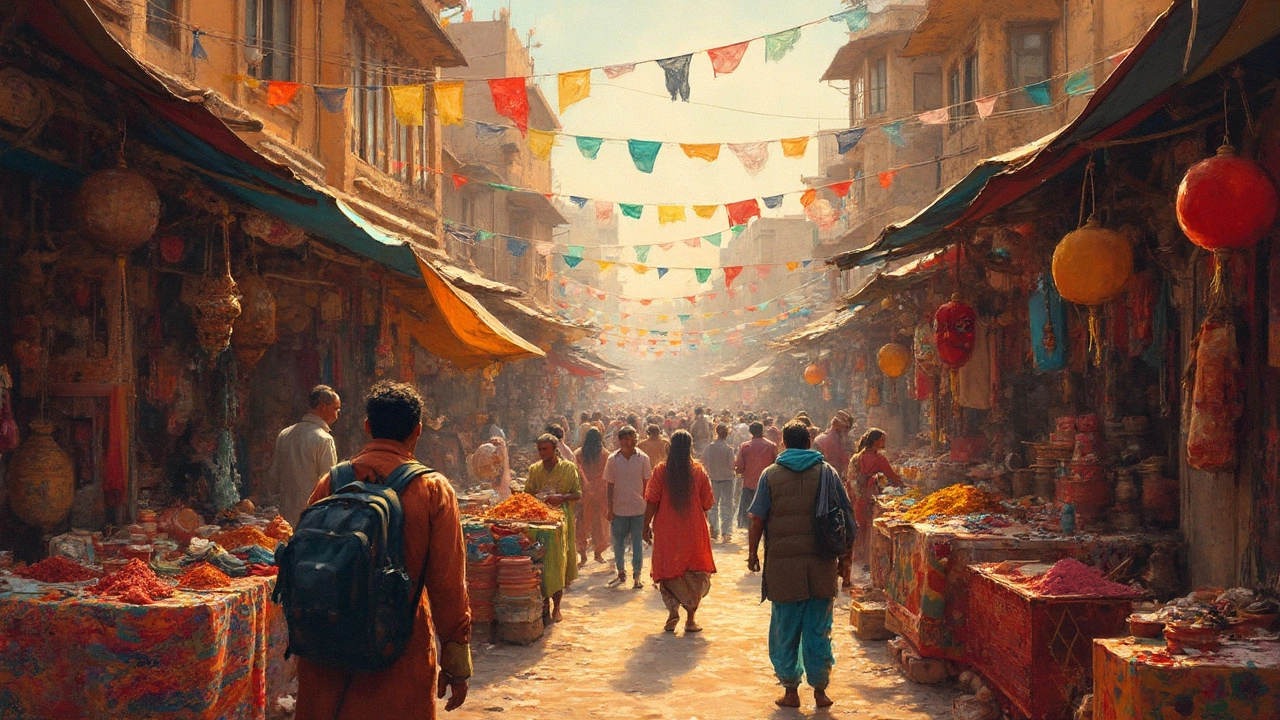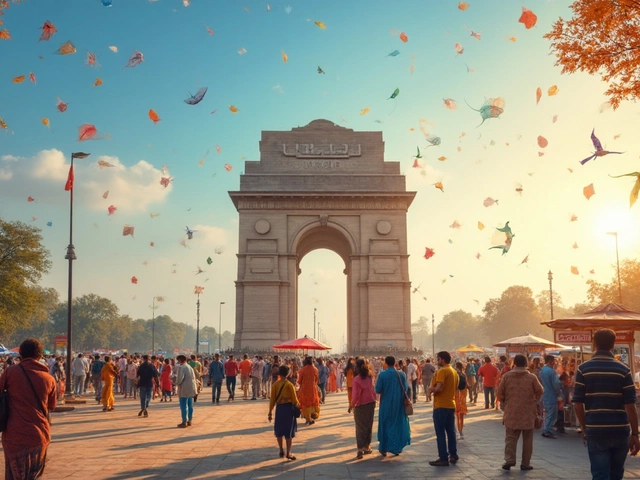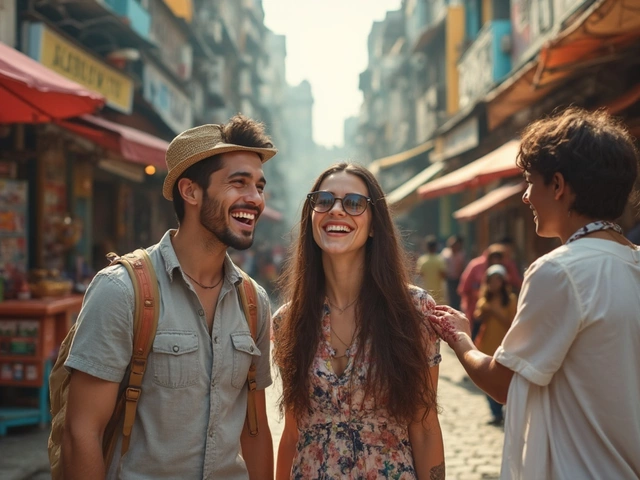So, you're thinking of heading to India, right? It's an incredible place with a dizzying variety of things to explore. But the big question is: how long should you stay? Let's break it down.
If you're on a tight budget and a strict schedule, two weeks can be enough to catch a few highlights. You can zip through the famous Golden Triangle—Delhi, Agra, and Jaipur—and still squeeze in a few relaxing days in places like Rishikesh or Goa. Just remember, India is massive, and every region feels like a different world, so more time equals more experience.
Here's a pro tip: domestic flights and trains are your best friends for covering large distances without busting your wallet. Booking flights in advance can snag you some super cheap deals, making it easier to hop around the country without burning through your cash. Likewise, train rides are more than just a means to an end—they're an experience in themselves, often providing insight into local life.
- Planning Your Itinerary
- Top Destinations to Visit
- Cultural Immersion Tips
- Budget Travel Hacks
- Best Time to Visit
- Safety and Etiquette
Planning Your Itinerary
Let's get real—budget travel in India is all about smart planning. To make the most out of your journey, you need to map out where you absolutely want to go and how to get there efficiently.
Setting Your Priorities
First things first, decide what's non-negotiable. Are you itching to explore ancient temples, or are the bustling markets calling your name? Maybe you just want to unwind on a Goan beach or trek in the Himalayas. Knowing your main interests can help you streamline your trip.
Time is of the Essence
With limited days, think strategically. A well-planned trip of 10-14 days can cover multiple key spots without feeling rushed. If you're stoked on cities, places like Delhi, Mumbai, or Bengaluru offer unique urban vibes. Meanwhile, Jaipur and Udaipur provide a more royal experience.
Efficient Transportation
Travel tips India veterans will tell you: book those domestic flights early! This trick keeps your costs down and travel swift. Also, consider India's expansive train network—a cheaper, slower, yet scenic ride that adds a flavorful layer to your adventure. Overnight trains save on accommodation costs too.
Sample Itineraries
- 1 Week: Spend a few days in Delhi, witness the Taj Mahal in Agra, then head to Jaipur. It's a whirlwind India travel guide intro.
- 2 Weeks: Add destinations like Varanasi, known for its spiritual significance, and Goa for some R&R by the beach.
- 3 Weeks: Include Kerala's backwaters or venture to Ladakh for high-altitude landscapes if time allows.
Get Local, Stay Flexible
Be ready for spontaneous adventures; sometimes the off-the-beaten-path spots turn out to be highlights. Chatting with locals often reveals hidden gems that aren't in any guidebook.
Finally, here’s a small reality check: delays are common, plans might shift, and that’s part of the charm. Stay flexible, and you'll likely have stories worth sharing for a lifetime.
Top Destinations to Visit
With a country as big and varied as India, it's tough to choose where to start. But if you're figuring out your stops, you'll want to hit some of these must-see destinations.
New Delhi
Delhi is both chaotic and charming, offering a mix of everything from street food to ancient forts. The capital's attractions like India Gate, Qutub Minar, and Humayun's Tomb are not to be missed. Remember to save some cash for the bustling markets like Chandni Chowk where bargaining is an art form.
Agra
Agra is famous worldwide for the stunning Taj Mahal. It's one of those landmarks that lives up to the hype. While you're in Agra, check out the Agra Fort and the ghost town of Fatehpur Sikri if time allows. Both offer a peek into the rich Mughal history.
Jaipur
Jaipur, known as the Pink City, is all about palaces and forts with stories to tell. The Hawa Mahal, Amber Fort, and City Palace provide a mix of architecture and history. And hey, if you're into colorful souvenirs, the bazaars here won't disappoint.
Varanasi
Varanasi is intense. It's one of the world's oldest cities and has a spiritual vibe you'll feel as you witness Ganga Aarti at the Ghats. The energy here is unique, and while the chaos is real, it's an essential stop for understanding India's cultural depth.
Goa
Switching gears, Goa is where chill meets charm. It's all about beaches, late-night parties, and incredible seafood. Whether you're lounging on Baga Beach or exploring the old Portuguese Fort Aguada, it's a welcome breath from the hustle of city life.
Kerala
Known as God's Own Country, Kerala offers a tropical taste with its backwaters and tea plantations. Cruising on a houseboat through the lavish greenery of Alleppey is something everyone should experience once.
These places are just the tip of the iceberg, really. If you've got more days to spare or a specific interest in trekking, yoga retreats, or culinary exploration, India has a lot more in store. Budget travel enables you to experience more for less, making it a playground for intrepid explorers ready to dive into its rich tapestry.
Cultural Immersion Tips
Diving headfirst into India's culture is more than just visiting famous sights. It's about embracing the day-to-day experiences that make this place unique. Here are some ways to get up close and personal with Indian culture.
Stay with Locals
One of the best ways to truly experience India is by staying with a local family. Homestays offer an authentic glimpse into daily life that you just can't get in a hotel. You'll be part of their routine, share meals, and even learn a few traditional recipes. Plus, hosts often share insider tips for exploring the area on a budget.
Join Local Celebrations
India is famous for its colorful festivals, and participating in one can be a highlight of your trip. Whether it's the chaos of Holi or the magic of Diwali, joining in on celebrations is both welcoming and enlightening. Remember to dress appropriately and respectfully immerse yourself in the festivities.
Learn Some Local Language
Picking up a few words in the local language can go a long way. While English is widely spoken, using basic Hindi phrases (or the local dialect) can earn you smiles and sometimes even discounts. Simple greetings or expressions show respect and interest.
Eat Like a Local
Street food is an adventure you shouldn't miss. Not only is it delicious and cheap, but it also gives you a taste of India's diverse food culture. Whether it's grabbing a plate of pani puri in Mumbai or savoring dosas in Chennai, your taste buds will thank you. Just remember, always choose busy stalls with high turnover to ensure freshness.
Use Public Transport
Using public transport is another way to understand local life. Take a bus or rickshaw to become a part of the everyday hustle, or hop on a train for longer journeys. These rides often lead to random, delightful encounters with friendly locals curious about your story.

Budget Travel Hacks
Alright, let’s talk about how to travel through India on a budget and still have a blast. Being smart with your money means more chai for you!
Accommodation Tips
First off, ditch the fancy hotels. Instead, check out hostels, guesthouses, or even homestays. Websites like Hostelworld and Booking.com offer tons of reviews, making it easier to find something comfy yet affordable. Staying in hostels not only saves cash but also helps you make friends and share stories with like-minded travelers. Don’t underestimate the warmth of local homestays either; they offer a unique glimpse into Indian family life.
Eat Like a Local
When it comes to food, eating local can save a lot of dough. Street food in India is not just cheap; it's legendary. Try dosa and idli in the south, chole bhature in the north, or any of the delicious snacks you find on the streets. Just watch where the locals are lining up—it's usually a sign of tasty and safe eats!
Getting Around
For transportation, trains are your budget-friendly choice. Book your tickets in advance through the Indian Railways website or their app. For shorter distances or within cities, hop on a rickshaw or a local bus. In cities like Mumbai and Delhi, local train and metro services are also cheap and reliable.
- Pro tip: Try Sleeper Class or AC Three-Tier on trains for long-distance comfort without the hefty price tag.
Embrace Bargaining
Bargaining is practically a sport in India. Whether you're shopping in bustling markets or hailing a rickshaw, don’t hesitate to haggle for a better price. It's part of the culture, and it can help you stretch your budget even further.
Travel Off-Season
If you’re not fussed about a little heat or rain, traveling during the off-peak months can save loads on accommodation and flights. Plus, tourist spots are less crowded, so you get a more genuine experience. Win-win!
Remember, being smart with these hacks means you get to see more, do more, and experience this vibrant destination without burning a hole in your pocket. Happy travels!
Best Time to Visit
Trying to figure out the best time to visit India can be puzzling, given its massive size and diverse climate zones. But let's make it simple: the peak season runs from October to March. This is when the weather's generally cool and dry, ideal for exploring without melting in the heat or getting drenched.
Peak Season: October to March
During these months, North India cools down, which is perfect for checking out iconic spots like the Taj Mahal and Jaipur's palaces. Down south, the weather is comfortable too, so think about cruising the backwaters of Kerala or walking along Goa's beaches. Keep in mind that attractions are busier, and prices for flights and accommodations might creep up. Booking ahead can help you snag better deals.Off-Peak Season: April to September
This is technically summer, followed by the monsoon. It gets wild hot, especially in places like Rajasthan, but if you're up for it, this time can be ideal for scoring bargains at hotels. Monsoon hits around June, with Kerala and the Western Ghats getting the heaviest rains. It might sound like a washout, but many folks find it enchanting to see the lush greenery and waterfalls.Festivals Worth Noting
Festivals are huge in India, and timing your trip around them can make your experience unforgettable. Consider planning your visit during Diwali if you're into vibrant celebrations, or join the revelry in Jaipur for the famous Elephant Festival. Just be prepared for crowds and book early.In summary, the best time to visit for a typical tourist is between October and March when the weather is cool. However, if you're looking to stretch your budget travel India experience further, consider the off-peak season. Every time has its charm, so it depends on what you're looking for!
Safety and Etiquette
Traveling in India is a remarkable adventure, but it's vital to keep safety in mind and respect local customs. Both are essential for having a smooth trip.
Staying Safe
First up, let's talk safety. India's bustling streets can be a little overwhelming at first. Always keep an eye on your belongings, especially in crowded areas like markets or train stations. It's wise to carry a money belt or a secure backpack.
Be cautious with street food—it's tempting, but avoid anything that looks like it's been out for too long to avoid an upset stomach. Opt for places that are busy with locals as the turnover means fresher food.
- Stick to bottled water or make sure you have a reliable water purifier.
- Use licensed taxis or ride-hailing apps like Uber; they're generally safer and more reliable.
- Save copies of your travel documents either digitally or as a hard copy.
Understanding Etiquette
Now, onto etiquette. India is a land of diverse cultures, and understanding local customs goes a long way in creating rapport with the locals. Always remove your shoes before entering someone's home or a temple. It’s a sign of respect.
Greeting people with a 'Namaste' with your hands pressed together is always appreciated. When visiting religious sites, dress modestly and adhere to any specific guidelines that might be in place.
- Avoid public displays of affection, as these can be frowned upon in many traditional areas.
- Your right hand is your best friend—use it for eating and giving or receiving anything.
- If you're invited to someone's home, a small gift like sweets or flowers is a thoughtful gesture.
With these tips in mind, you're all set to explore India confidently and respectfully, making the most of your budget travel India experience while understanding and embracing the incredible cultural nuances of this vast country.



